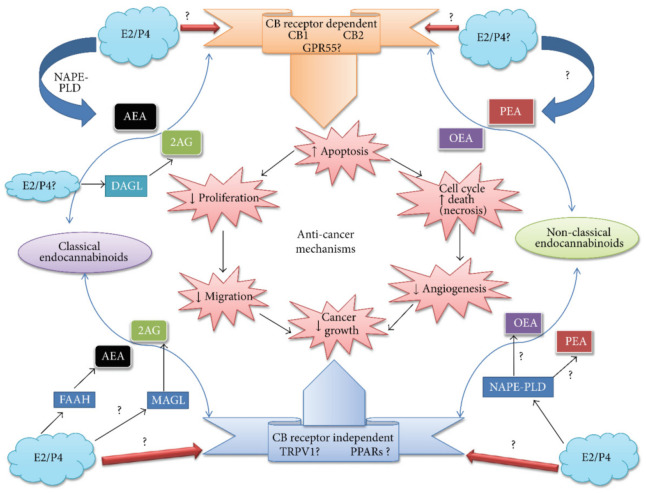Figure 5.
Putative collaborations between sex hormone-dependent cancers and the ECS (endocannabinoid system). The production of ECs is carried out by the actions of specific enzymes (light yellow boxes and broad blue arrows). These actions are supported by the enzymatic hydrolysis of NArPE lipid precursors, particularly associated with the membrane. Both sex steroid hormones perform theoretical roles in the pathway. Both hormones, such as progesterone (represented as P4 at each corner in the circle filled with light blue color) and oestradiol (represented as E2 at each corner in the circle filled with light blue color). 2-arachidonoylglycerol (2-AG) and anandamide (N-arachidonoylethanolamide, AEA) are known as classical ECs. The non-classical ECs are recognized as PEA and OEA. Both forms of ECs (i.e., classical and non-classical) bind independently or in concert at receptors CB1, CB2, and GPR55. Receptors PPAR and TRPV1 (represented in gold cold fill boxes) involve in the anticancer mechanism. Green boxes show the important activities linked to the anticancer mechanism in the center of the figure. There are speculated observations; either all these activities are interconnected or perform functions independently. Although this mechanism significantly reduced the mass of cancer cells. The ECS and its adjusting boundaries with sex steroid hormones are represented in the anticancer mechanisms, though theoretical or unidentified associations are specified using a question mark(s). ↑ ↓ Arrows illustrated the increasing or decreasing activity of a particular anticancer mechanism. Reprinted from Ref. [196] with permission under open access article distributed under the Creative Commons Attribution License. Abbreviation: NAPE-PLD (N-acyl phosphatidylethanolamine phospholipase D); OEA (oleoylethanolamide); PEA (palmitoylethanolamide); PPAR (peroxisome proliferator-activated receptor); TRPV1 (transient receptor potential vanilloid type-1); AEA (arachidonoylethanolamide); FAAH (fatty acid amide hydrolyse); MAGL (monoacylglycerol lipase); DAGL (diacylglycerol lipase).

